
Homogeneous Catalysis
.pdf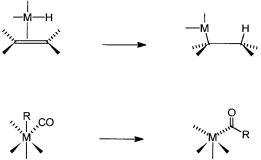
IMPORTANT REACTION TYPES |
23 |
Figure 2.7 cis insertions of alkene and CO into metal–hydrogen and metal–alkyl bonds, respectively.
Reaction 2.11, although proposed in CO hydrogenation reactions, is thermodynamically unfavorable, that is, there is a net loss in bond energy in breaking a metal–hydrogen bond and forming a carbon–hydrogen one. There is so far no clear example of insertion of CO into a metal–hydrogen bond. This does not mean, of course, that such a reaction, if it does take place at all, will be slow. Indeed, if such a reaction is fast, and is followed by other reactions that make up for the loss in bond energy, then it certainly could be the initial step in CO hydrogenation. We shall discuss this point in greater detail in Section 4.4. Finally, it should be noted that insertion reactions, as shown in Fig. 2.7, are cis in character.
2.3.3-Hydride Elimination
We have already seen in Section 2.2.2 that metal–alkyl compounds are prone to undergo -hydride elimination or, in short, -elimination reactions (see Fig. 2.5). In fact, hydride abstraction can occur from carbon atoms in other positions also, but elimination from the -carbon is more common. As seen earlier, insertion of an alkene into a metal–hydrogen bond and a -elimination reaction have a reversible relationship. This is obvious in Reaction 2.8. For certain metal complexes it has been possible to study this reversible equilibrium by NMR spectroscopy. A hydrido–ethylene complex of rhodium, as shown in Fig. 2.8, is an example. In metal-catalyzed alkene polymerization, termination of the polymer chain growth often follows the -hydride elimination pathway. This also is schematically shown in Fig. 2.8.
2.3.4Nucleophilic Attack on a Coordinated Ligand
Upon coordination to a metal center the electronic environment of the ligand obviously undergoes a change. Depending on the extent and nature of this change, the ligand may become susceptible to electrophilic or nucleophilic
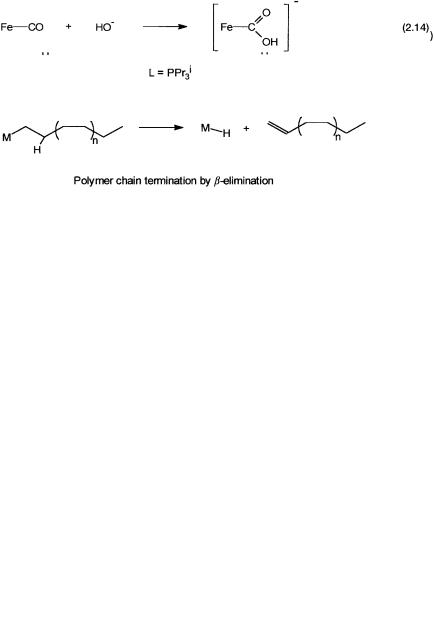
24 BASIC CHEMICAL CONCEPTS
Figure 2.8 Top: The relationship between insertion of an alkene into a metal–hydro- gen bond and the reverse -elimination reaction for a rhodium complex. Bottom: - elimination leading to the formation of a metal hydride and release of a polymer molecule with an alkene end group.
attack. It is the enhanced electrophilicity or tendency to undergo nucleophilic attack that is often encountered in homogeneous catalytic processes. A few examples are shown by Reactions 2.12–2.14.
Nucleophilic attack by water on coordinated ethylene, as shown by Reaction 2.12, is the key step in the manufacture of acetaldehyde by the Wacker process (see Chapter 8). In Reaction 2.13 the high oxidation state of titanium makes the coordinated oxygen atom sufficiently electrophilic for it to be attacked by an alkene. As we will see in Chapter 8, this reaction is the basis for the homogeneous catalytic epoxidation of alkenes, using organic hydroperoxides as the oxygen atom donors.
The last reaction (2.14) has relevance as a model in the base-promoted water gas shift reaction, and is similar to Reaction 2.12. Instead of palladiumcoordinated ethylene it is iron-coordinated carbon monoxide that undergoes attack by HO . The extent to which the reactivity of the ligand may be affected
CATALYTIC CYCLE AND INTERMEDIATES |
25 |
on coordination is often reflected in the rate constants. The ratio of the rate constants of nucleophilic attack by hydroxide on coordinated and free CO may be as high as 109!
2.4 ENERGY CONSIDERATIONS—THERMODYNAMICS AND KINETICS
For a chemical reaction to be experimentally observed, the thermodynamic and the kinetic changes should not be too unfavorable. The thermodynamic change is measured in terms of the change in Gibbs free energy, or simply free energy ( G ), while the kinetic requirement is measured by free energy of activation ( G #).
A thermodynamically favorable reaction ( G < 0) may not take place because the free energy of activation may be too high. On the other hand, a thermodynamically unfavorable reaction ( G > 0) may occur if the free energy of activation is low. There are many examples: The conversion of diamond to graphite is thermodynamically favorable but happens only at a vanishingly small rate at room temperature and pressure. A mixture of nitrogen and hydrogen does not automatically form ammonia; a considerable amount of energy has to be provided to overcome the activation energy barrier.
The relationship between G and G # is normally presented in a diagram, where free energies of the reactants, products, transition state, and intermediates are plotted against the extent of reaction, or more precisely the reaction coordinate. This is shown in Fig. 2.9. Even a simple homogeneous catalytic reaction such as alkene hydrogenation involves many intermediates and transition states. The free energy diagram thus resembles (c) rather than (a) or (b).
Finally, the relationship between equilibrium constant and free energy change in the standard state on the one hand, and rate constant and energy of activation on the other, are given by Eqs. 2.15 and 2.16, respectively. For calculating the G # of a given reaction, H # and S # of the same reaction are calculated first. This is done by plotting ln(k/T ) against 1/T, where the slope and the intercept give the measures of H # and S #, respectively. This type of a diagram is called an Eyring plot. A plot of ln k against 1/T is, of course, the Arrhenius plot and is used for measuring activation energy ( E )
RT ln K = G 0 |
(2.15) |
k = Ae E/RT |
(2.16) |
2.5CATALYTIC CYCLE AND INTERMEDIATES
Consider a hypothetical metal complex MLn 1 (M = metal, L = ligand, n 1 = number of ligands) that acts as a catalyst for the hydrogenation of an alkene. Also consider the following sequence of reactions:
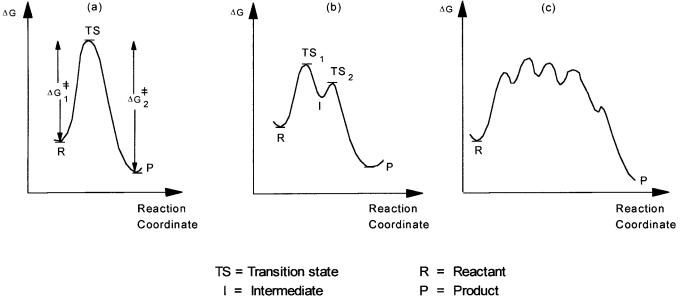
26
Figure 2.9 Hypothetical free energy diagrams. In (a) there is no intermediate and G = G #2 G #1. In (b) there is an intermediate
(I). The two transition states TS1 and TS2 would determine the kinetic behavior of the overall reaction. (c) Schematic depiction of a free energy diagram for an apparently simple catalytic reaction where a number of transition states and intermediates are involved.

CATALYTIC CYCLE AND INTERMEDIATES |
27 |
MLn 1 ` MLn L
MLn H2 ` H2MLn
H2MLn alkene ` H2MLn (alkene)
H2MLn (alkene) ` HMLn (alkyl)
HMLn (alkyl) → MLn alkane
If all these reactions excepting the first are added, we get the net stoichiometric reaction alkene H2 → alkane. The metal complex MLn reacts with dihydrogen in the first step, undergoes a series of reactions in the following steps, and is regenerated in the final step. As shown in Fig. 2.10, all these reactions are conveniently presented as a catalytic cycle.
The following points are worth noting about the sequence of reaction presented in this cyclical manner. The stable metal complex added to the reaction
Figure 2.10 A hypothetical catalytic cycle with the precatalyst MLn 1 and four catalytic intermediates.
28 BASIC CHEMICAL CONCEPTS
at the beginning, MLn 1, is called the precatalyst or the catalyst precursor. All four metal complexes, MLn, H2MLn, H2MLn (alkene), and HMLn (alkyl), that are present within the cycle are called catalytic intermediates. One complete catalytic cycle is derived from one molecule of the precatalyst and produces one molecule of the product. Turnover frequency in terms of a catalytic cycle is therefore the number of times the cycle is completed in unit time.
Information about the catalytic cycle and catalytic intermediates is obtained by four methods: kinetic studies, spectroscopic investigations, studies on model compounds, and theoretical calculations. Kinetic studies and the macroscopic rate law provide information about the transition state of the rate-determining step. Apart from the rate law, kinetic studies often include effects of isotope substitution and variation of the ligand structure on the rate constants.
Spectroscopic studies may be carried out under the actual catalytic conditions. These are referred to as in situ spectroscopic investigations. However, if the catalytic conditions are too drastic, it may not be possible to record spectra under such conditions. In such cases spectroscopic monitoring is done under less severe conditions.
Both kinetic studies and spectroscopic investigations have certain inherent limitations. Kinetic studies are informative about the slowest step, and at best can provide only indirect information about the fast steps. Spectroscopic detection of a complex, catalytically active or not, requires a minimum level of concentration. It is possible that the catalytically active intermediates never attain such concentrations and therefore are not observed. Conversely, the species that are seen by spectroscopy may not necessarily be involved in the catalytic cycle!
However, in most cases a combination of kinetic and spectroscopic methods can resolve such uncertainties to a large extent. The third method is based on the study of model compounds. Model compounds are fully characterized metal complexes that are assumed to approximate the actual catalytic intermediates. Studies on the reactions of such compounds can yield valuable information about the real intermediates and the catalytic cycle. With the advent of computational speed and methods, quantum-mechanical and other theoretical calculations are also increasingly used to check whether theoretical predictions match with experimental data.
We now discuss a few examples where these methods have yielded results that are particularly instructive. It must, however, be remembered that in most cases a combination of more than one method is necessary for an understanding of the observed catalysis at a molecular level.
2.5.1Kinetic Studies
Dependence of reaction rates on the concentrations of the reactants (and the products in certain cases) can be very useful in understanding the mechanism of catalysis. Some of the ubiquitous mechanistic steps reveal themselves in empirically derived rate expressions. In other words, such rate expressions, once established by experiments, are characteristic signs of such steps.
CATALYTIC CYCLE AND INTERMEDIATES |
29 |
One of the mechanistic steps most often encountered and inferred from kinetic data is ligand dissociation, which leads to the generation of a catalytically active intermediate. If ligand is added to such a catalytic system, the rate of the reaction decreases. Examples of this in homogeneous catalytic reactions are many: CO dissociation in cobalt-catalyzed hydroformylation, phosphine dissociation in RhCl(PPh3)3-catalyzed hydrogenation, Cl dissociation in the Wacker process, etc. The actual rate expressions of most of these processes are described in subsequent chapters.
Another type of kinetic behavior that is very common for enzyme-catalyzed reactions (Michaelis–Menten kinetics) has also been observed in a number of homogeneous catalytic systems. The rate expression in such cases is given by
rate = kK [substrate][catalyst]/(1 K [substrate]) |
(2.17) |
where k is the rate constant, K is an equilibrium constant, and the square brackets signify concentrations. Kinetic behavior of this type is often called saturation kinetics. The physical significance of saturation kinetics is that a complex is formed between the substrate and the catalyst by a rapid equilibrium reaction. The equilibrium constant of this reaction is K, and it is then followed by the rate-determining step with rate constant k.
From the rate expression it is easy to see that increasing the substrate concentration will lead to an increase in rate initially, followed by a more or less constant rate at high substrate concentrations. The reason for this is that at high substrate concentrations K [substrate] 1 K [substrate]. Note that at constant catalyst concentration, a plot of (1/rate) against (1/[substrate]) will give a straight line. Saturation kinetics is observed in a number of homogeneous catalytic reactions such as hydrogenation, asymmetric hydrogenation, some epoxidation reactions, etc.
It must be remembered that with a change in reaction conditions a change in mechanism may also occur. What happens to be the rate-determining step under one set of reaction conditions need not necessarily be the ratedetermining step under different conditions. A very good example of this is the Eastman Kodak process for methyl acetate carbonylation. Here there are two potential rate-determining steps. Which one of the two actually becomes slower obviously depends on the concentrations of the different reactants. This is discussed in detail in Section 4.6. Finally, as will be seen in subsequent chapters, there are many examples where isotope labeling and its effect on the rate or stereochemistry provide crucial mechanistic insights.
2.5.2Spectroscopic Studies
Both infrared and multinuclear NMR spectroscopies have been used to identify homogeneous catalytic intermediates. These spectroscopic methods, if they are
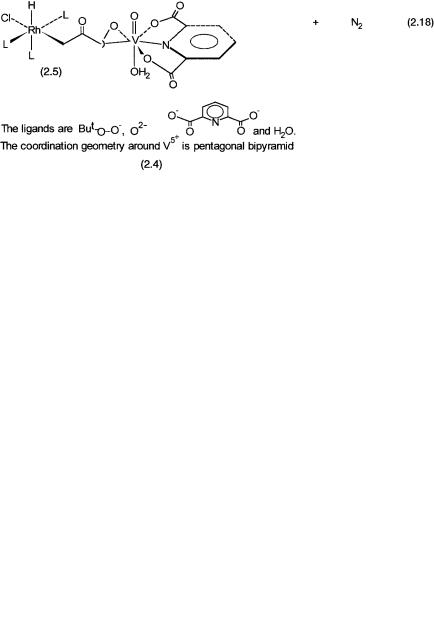
30 BASIC CHEMICAL CONCEPTS
to be used for studying reactions under drastic conditions (i.e., high pressure and temperature), require careful choice of construction material and design of the spectroscopic cell.
A porphyrin complex of rhodium catalyzes the reactions between diazomethane derivatives and alkenes to give cyclopropane rings. This is shown by:
A study of this reaction is an appropriate example of the usefulness of spectroscopic method in mechanistic studies. 1H NMR studies on the reaction between the catalyst and the diazo compound show complexes 2.1 and 2.2 of Fig. 2.11 to be present in the reaction mixture. Complex 2.1 is stable at 40 C, and on warming to 0 C it undergoes conversion to 2.2. This reaction i.e., conversion of 2.1 to 2.2 is one of the several pieces of evidence for the intermediacy of the carbene complex 2.3. In other words, in situ NMR data, in conjunction with other evidences, indicate the involvement of 2.3 as a catalytic intermediate.
2.5.3Model Compounds and Theoretical Calculations
Many compounds have been synthesized, characterized, and studied as models for proposed intermediates in various homogeneous catalytic reactions. Here we discuss two examples. Complex 2.4 is proposed as a model that shows the mode of interaction between an organic hydroperoxide and high-valent metal ions such as Ti4 , V5 , and Mo6 . This type of interaction is considered to be necessary for the oxygen atom transfer from the hydroperoxide to an alkene to give an epoxide (see Chapter 8).
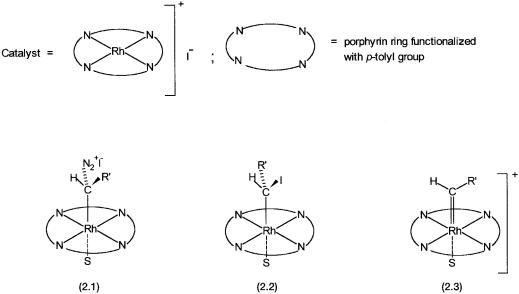
Figure 2.11 Catalytic intermediates identified and proposed on the basis of multinuclear lowtemperature NMR studies on cyclopropanation of alkenes with derivatives of diazomethane.
31
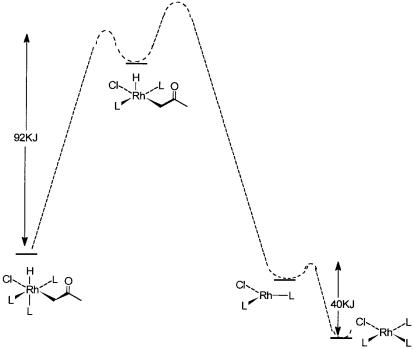
32 BASIC CHEMICAL CONCEPTS
The second example, 2.5, is a model for a hydrido–alkyl complex. This was studied structurally and kinetically to gain insight into the reductive elimination process that leads to the formation of an alkane. Complex 2.5 is synthesized by reacting RhCl(PPh3)3 with propylene oxide. This complex eliminates acetone to go back to RhCl(PPh3)3. Acetone, however, does not oxidatively add to RhCl(PPh3)3 to give 2.5, which is why this complex had to be made by the clever use of propylene oxide. The data obtained from kinetic studies on the acetone elimination reaction have been used to construct the free energy diagram shown in Fig. 2.12.
This diagram illustrates many important points. First of all, it shows the mechanistic complexity that may be anticipated for even an apparently simple reaction, reductive elimination of acetone from 2.5. Second, it shows that RhCl(PPh3)3 is thermodynamically more stable than complex 2.5 by about 40 kJ/mol. However, complex 2.5 does not undergo spontaneous conversion to RhCl(PPh3)3 because it has sufficient kinetic stability (>92 kJ/mol). Third, the high free energy of activation is associated with a ligand dissociation step that precedes the reductive elimination step. The five-coordinated intermediate, once
Figure 2.12 A free energy diagram for the reductive elimination of acetone from a model complex. Note the high activation energies required for the forward and the backward reactions.
